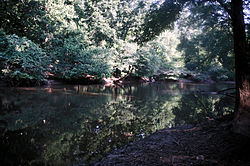Camden Expedition Sites National Historic Landmark
Camden Expedition Sites | |
 Ferry crossing at Jenkins' Ferry Battlefield | |
| Location | Clark, Cleveland, Grant, Hempstead, Nevada, Ouachita counties, and possibly Pulaski County |
|---|---|
| NRHP reference No. | 70000127 |
| Designated NHLD | April 19, 1994[1] |
The Camden Expedition Sites are a National Historic Landmark District consisting of eight historic sites where events of the American Civil War's Camden Expedition occurred. The sites are spread across six or seven counties.
- Elkin's Ferry Battleground, in Clark and Nevada counties
- Prairie d'Ane Battlefield, near Prescott in Nevada County
- the Confederate State Capitol building, in Historic Washington State Park, Hempstead County
- Fort Southerland on Bradley Ferry Road,[2] in Camden, Ouachita
- Fort Lookout on Van Buren Road,[2] in Camden, Ouachita County
- Poison Springs Battleground State Park, a state park on Highway 76,[2] near Chidester in Ouachita County.
- Marks' Mills Battlefield, a state park near New Edinburg in Cleveland County
- Jenkins' Ferry Battlefield, a state park near Leola in Grant County
Each of the sites is individually listed on the National Register of Historic Places. The National Historic Landmark District was declared in 1994.[1][3]
It is stated at the National Historic Landmark summary that there are nine sites included in the NHL, although that summary only lists only the above eight by name.[1] The landmark nomination document clearly describes only eight sites.[3] An Arkansas state webpage states that the Old U.S. Arsenal Building (meaning the Tower Building of the Little Rock Arsenal, in Little Rock, Pulaski County, Arkansas, where the expedition started) is included in the landmark.[2] The photo set that accompanies the landmark nomination includes photos of the U.S. Arsenal Building as well as of the eight other sites, so it is unclear whether the Arsenal site is part of the landmark or not. It is unclear whether it was intended to be included but was dropped, or whether it was added after the nomination document was completed.
Historical background
The 1864 Camden Expedition was part of a two-pronged strategy by the Union Army to drive Confederate resistance out of southwestern Arkansas and northern Louisiana, and to penetrate into Confederate Texas. Union Major General Frederick Steele led a Union force from Little Rock on March 23, 1864, with the objective of joining forces with Major General Nathaniel Prentice Banks at Shreveport, Louisiana. Confederate forces in Arkansas were directed from Washington, where the Confederate government of the state relocated after the fall of Little Rock. Confederate Major General Sterling Price ordered Brigadier General John S. Marmaduke to harry the Union column and to prevent it from crossing the Little Missouri River as it moved toward Washington. Advance Union forces established a beachhead on the south side of the Little Missori on April 3, and clashed with Confederate defenders in the Battle of Elkin's Ferry. The outnumbered Confederates were forced to withdraw, and General Price established a defensive position, lightly fortified by earthworks, on the road between Elkin's Ferry and Washington at the western edge of the sparsely-populated Prairie d'Ane, a roughly circular area of prairie surrounded by woodlands.[3]
After waiting for the arrival of reinforcements, General Steele advanced on April 9, but was stopped in the Battle of Prairie D'Ane, a series of encounters that ended on April 12. Steele then withdrew to Camden, in order to resupply his army, which was then on half-rations. Price had stripped Camden of personnel in order to defend Washington, and the Union forces occupied the city against no significant opposition. Operations to resupply the army at Camden were frustrated by the Battle of Poison Spring (April 18) and the Battle of Marks' Mills (April 25). The latter was particularly devastating, as the Confederates captured most of the supply column, numbering some 1,400 troops and more than 200 supply wagons. Steele then abandoned Camden and retreated back toward Little Rock. The pursuing Confederate forces caught up with him at Jenkins' Ferry, where they fought a largely indecisive but bloody battle on April 30.[3]
See also
- List of National Historic Landmarks in Arkansas
- National Register of Historic Places listings in Clark County, Arkansas
- National Register of Historic Places listings in Cleveland County, Arkansas
- National Register of Historic Places listings in Grant County, Arkansas
- National Register of Historic Places listings in Hempstead County, Arkansas
- National Register of Historic Places listings in Nevada County, Arkansas
- National Register of Historic Places listings in Ouachita County, Arkansas
- National Register of Historic Places listings in Pulaski County, Arkansas
References
- ^ a b c "Camden Expedition Sites". National Historic Landmark summary listing. National Park Service. 2007-09-26.
- ^ a b c d "Arkansas National Historic Landmarks". work. Arkansas Historic Preservation Program. 2007-09-26.
- ^ a b c d Edward C. Bearss and James H. Charleton (November 29, 1993). "National Historic Landmark Nomination: Camden Expedition Sites" (Document). National Park Service.
{{cite document}}: Unknown parameter|format=ignored (help); Unknown parameter|url=ignored (help) and Template:PDFlink

